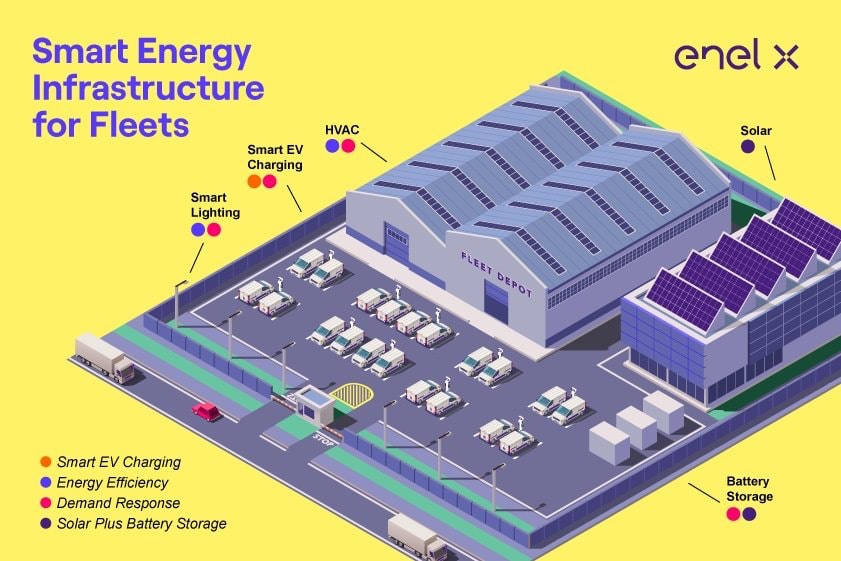How EV Fleets Can Help Corporates Thrive

Consumers have contributed to an enormous increase in electric vehicle (EV) adoption in recent years due to increasing environmental consciousness and the desire to save on fuel costs. With increasing demand from EV fleet drivers, support from the Biden administration and more affordable EV models from leading OEMs, more corporations and Fortune 1000 companies are beginning to electrify their fleets and seeing benefits to their bottom line.
Lower Total Cost of Ownership (TCO)
Whether running a fleet of company vehicles for employee use or other business operations, EVs offer huge savings over the vehicle’s lifetime. On average, light-duty electric vehicles see a lifetime savings of about $6,000-$10,000 compared to gas-powered vehicles, whereas heavy-duty electric vehicles can see a lifetime savings of up to $300,000. These savings come not only from reduced fuel costs but also from reduced maintenance costs as well.
The energy cost per mile driven is the best way to compare fuel costs between gasoline and electric vehicles. Analyses show that EVs across the board are more cost effective and lower energy costs per mile compared to gas-powered cars — even if gasoline dropped to $2 a gallon and the cost of electricity tripled. With projections showing a stable and even slight decrease in the cost of electricity over the next 30 years, it’s a safe bet that a fleet of EVs will cost less to get where they need to go.
Maintenance costs also see a reduction with EVs due to the streamlined simplicity of the drivetrain. The electric motor constitutes the single moving part — there are no internal combustion oils or fluids. This translates to fewer parts that wear, tear and break down. Multiply that over an entire fleet, and savings add up quickly.
Fleet of Electric Vehicles: Building Resilience
While Fortune 1000 companies such as Biogen and FedEx are increasingly electrifying their fleets primarily for sustainability and financial benefits, they are realizing that EVs are increasingly proving to be more efficient and resilient than gas-powered vehicles.
Transitioning to electric vehicles is a meaningful strategy to reduce scope 3 emissions. EV fleets can help decrease a company’s emissions and improve air quality. Companies also get access to lower fuel rates and government-backed environmental incentives. The Biden Administrations’ recent $174 billion infrastructure package supports the domestic production of EVs and 500,000 EV fleet charging stations.
Commercial smart charging stations with load balancing features offer even more value. These stations can be installed on-site to sell the clean electricity generated to clients, customers, and visitors with EVs. As a result, they’re able to increase revenue while giving fleet customers cost savings. With all of these additional benefits in play, investors are increasingly preferring companies with greater environmental commitments. Although the exact results depend on a company’s unique situation (access to incentives, tariffs, metering structures, company needs, etc.), the positives are too great to ignore.
Trendsetting Employers Attract Trailblazing Talent
Millennial investors are a major reason electric vehicles are gaining in popularity. A recent study showed that 85% of these younger investors desire investments that align with their values for a cleaner, brighter future. And they’re bringing a ripple of changes with them. For starters, some exchange-traded fund (ETF) providers, such as Vanguard, are now offering ESG-focused funds to their clients.
Employers can offer incentives and perks to EV fleet drivers, such as free EV fleet charging at work. Local, state, and federal governments and utilities also provide rebates for an EV charging station and installation.
But the rewards of such a change are significant. Going green reduces business costs, offers tax credits, rebates and savings, and provides a competitive advantage. In fact, studies have shown that sustainable corporations perform better financially. Progressive states such as New York, California, and New Jersey are among the first to push EV adoption, mandating that all new cars and passenger trucks sold in these states must be zero-emission vehicles by 2035. Companies such as the Enel Group are making the transition easier. Having electrified more than 1,500 vehicles to date, the global utility aims to achieve full decarbonization by 2050.
The JuiceBox smart charger has dominated the smart home charging market for several years and is trusted by thousands of drivers. Using Enel X’s JuiceEco and the JuiceBox smart charger, Uber drivers can now match their electric vehicle charging with zero-emission, 100% renewable energy using Renewable Energy Certificates (RECs), a benefit typically reserved for businesses and institutions.
When big companies, like Uber, increase their EV incentives it encourages more drivers to move toward EV adoption, as the gig economy continues to grow for many communities Overall, businesses have an important responsibility in the energy transition. By electrifying their own operations and providing opportunities for consumers to adopt electric vehicles, they pave the way for a brighter, cleaner future.
For more on understanding how to maximize savings with EV Charging, download our eBook.
To find an incentive near you, visit our website.


